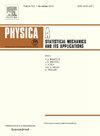Co-evolutionary dynamics of threshold PGGs with collective-risk environment feedback
IF 2.8
3区 物理与天体物理
Q2 PHYSICS, MULTIDISCIPLINARY
Physica A: Statistical Mechanics and its Applications
Pub Date : 2025-01-15
DOI:10.1016/j.physa.2024.130275
引用次数: 0
Abstract
At present, the collective-risk dilemma game has recognized the feedback loops between strategies and collective-risk. However, understanding how individual decision-making in complex real-world societies impacts collective-risk, and in turn influences individual strategies through such feedback mechanisms, remains an area that requires further exploration. We consider the co-evolutionary dynamics based on threshold Public Goods Games (PGGs) under collective-risk. First, this co-evolutionary game framework can be divided into two parts: threshold PGGs and the dynamics of collective-risk. The former represents the group dynamics of betrayal and cooperation strategies, while the latter can be seen as the evolutionary dynamics of collective-risk under strategic influences. Next, we examine the presence and stability of possible equilibrium points that could emerge from co-evolutionary dynamics. Subsequently, we introduce the method of manifold control to extend the framework and guide the co-evolutionary dynamics of threshold PGGs to a certain extent. Finally, a particular example is presented to validate the theoretical approaches. In summary, the method of manifold control offers a new perspective for exploring collective cooperation in the context of collective-risk dilemmas.
求助全文
约1分钟内获得全文
求助全文
来源期刊
CiteScore
7.20
自引率
9.10%
发文量
852
审稿时长
6.6 months
期刊介绍:
Physica A: Statistical Mechanics and its Applications
Recognized by the European Physical Society
Physica A publishes research in the field of statistical mechanics and its applications.
Statistical mechanics sets out to explain the behaviour of macroscopic systems by studying the statistical properties of their microscopic constituents.
Applications of the techniques of statistical mechanics are widespread, and include: applications to physical systems such as solids, liquids and gases; applications to chemical and biological systems (colloids, interfaces, complex fluids, polymers and biopolymers, cell physics); and other interdisciplinary applications to for instance biological, economical and sociological systems.

 求助内容:
求助内容: 应助结果提醒方式:
应助结果提醒方式:


